Reeeeecoooon !!!
Let´s know an american wheeled vehicle designed for reconnaissance and armed patrols: the M8 Greyhound 6x6 Light Armored Car.
The M8 light armored car is a 6x6 armored car produced by the Ford Motor Company during World War II. It was used by the United States and other allies.
 |
| M8 from Combat Command B, 7th Armored Division in support of A Company, 23rd Infantry Regiment. Epernay, east of Chateau Thierry, Marne River - August, 1944. The drawing above was based in this pic. |
In British service, the M8 was known as the "Greyhound". The British Army found it too lightly armored, particularly the hull floor, which anti-tank mines could easily penetrate (the crews' solution was lining the floor of the crew compartment with sandbags). Nevertheless, it was produced in large numbers. The M8 Greyhound's excellent mobility made it a great supportive element in the advancing American and British armored columns.
In July 1941, the ordnance department initiated a development of a new fast tank destroyer to replace the M6 37 mm gun motor carriage, which was essentially a ¾-ton truck with a 37 mm gun installed in the rear bed.
 |
| M6 GMC 37mm - Notice the unusual AA MG .50 in the front bumper |
The requirement was for a 6x4 wheeled vehicle armed with a 37 mm gun, a coaxial machine gun mounted in a turret, and a machine gun in the front hull. Its glacis armor was supposed to withstand fire from a .50 in (12.7 mm) machine gun and side armor from a .30 in (7.62 mm) machine gun. Prototypes were submitted by Studebaker (designated T21), Ford (T22) and Chrysler (T23), all of them similar in design and appearance.
 |
| Studebaker T21 |
 |
| Ford T22 |
 |
| Chrysler T23 |
In April 1942, the T22 was selected despite complaints about deficiencies, due to the need for vehicles. By then, it was clear that the 37 mm gun would not be effective against the front armor of German tanks; so, the new armored car, designated M8 light armored car, took on a reconnaissance role instead.
 |
| M8 Ford Light Armored Car 6x6 |
Contract issues and minor design improvements delayed serial production until March 1943. Production ended in June 1945. A total of 8,523 units were built, excluding the M20 armored utility car (see variants). The M8 was manufactured at the Ford Motor Company plant in Saint Paul, Minnesota.
 |
| M20 Armored Utility Car 6x6 |
In May 1942, having viewed the prototype, the British Tank Mission turned down the offer to acquire the M8 through Lend-Lease. It was named "Greyhound" in keeping with other U.S. armored cars already ordered by the British, such as the (cancelled) T18 Boarhound, the T17 Deerhound, the T17E1 Staghound and the (also cancelled) M38 Wolfhound.
 |
| T18 Boarhound 8x8 |
 |
| T17 Deerhound 6x6 |
 |
| T17E1 Staghound 4x4 |
 |
| M38 Wolfhound 6x6 |
Mission and operational performance:
The cavalry recon troop served as a division's or corps' advance "eyes and ears". This mission demanded speed and agility, not firepower and armor. When on the march, the cavalry's mission was to make contact with enemy forces at the earliest practicable moment and maintain it thereafter. In this role, the recon troops identified hostile units and reported their strength, composition, disposition and movement. During withdrawals, the cavalry often served as a screening force for the main units.
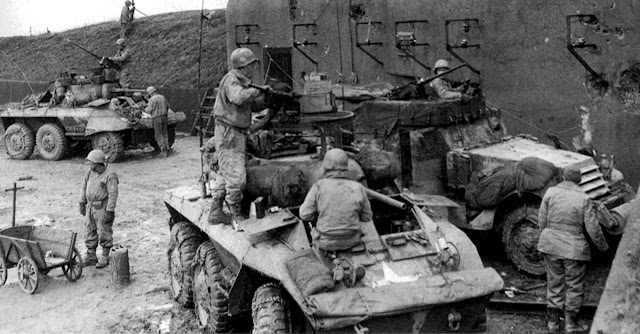 |
| M8´s and M3 from 92nd Cavalry Recon Squadron prepares for an attack from behind the cover of the Maginot Line´s. France, 1944 |
The M8 performed this function with distinction. Each M8 armored car was equipped with a long-range radio set to assist in the exercise of command, or for the purpose of relaying information received from subordinate elements to higher headquarters. Another short-range radio set served to communicate within a cavalry reconnaissance platoon, reconnaissance team, or with headquarters. The M8 weighed 16,400 lb (7,400 kg) fully loaded with equipment and crew, and was capable of cruising 100–200 mi (160–320 km) cross country or 200–400 mi (320–640 km) on highways without refueling. On normal roads, it was capable of a sustained speed of 55 mph (89 km/h), hence its nickname.
The M8 was not designed for offensive combat, and its firepower was adequate only against similar lightly armored enemy vehicles and infantry. The vehicle's armor provided a fair degree of protection against small-arms fire but nothing more. With a meager .12 in (3 mm) of floor armor, the M8 was particularly vulnerable to German mines.
 |
| An M8 mined in Italy. Notice the the damage caused by the explosive on the front wheel and the vehicle floor |
The vehicle's other drawback was limited mobility in heavily wooded areas and on broken terrain, and armored cavalry units preferred using the ¼-ton reconnaissance car (Jeep) in these environments. A large turning radius, limited wheel travel, open differentials, and limited cross-country mobility made the M8 armored car susceptible to immobilization off-road in off-camber terrain and defiles.
This limited operators to using the vehicle mostly on existing roads and paths, where it became vulnerable to ambush. The lack of continuous tracks and poor tread contact area-to-weight ratio also hampered its off-road performance in mud, snow and alpine terrain and, in soft terrain, the M8 frequently sank to its axles. Conversely, performance on hard surfaces was exceptional. As a wheeled vehicle, the M8 was generally more reliable than tracked vehicles of similar size, and required far less maintenance and logistics support.
 |
| M8 in patrol duties... |
M8 Description:
The M8 was fitted with a 37 mm M6 gun (aimed by M70D telescopic sight) and a coaxially mounted .30 in (7.62 mm) Browning machine gun in an open-topped, welded turret.
A .50 in (12.7 mm) M2 Browning machine gun was sometimes carried on a ring or pintle mount for anti-aircraft use; this was not standard on early vehicles, but was a frequent unit modification.
A .50 in (12.7 mm) M2 Browning machine gun was sometimes carried on a ring or pintle mount for anti-aircraft use; this was not standard on early vehicles, but was a frequent unit modification.
 |
| M8 fully restored showing the .50 in (12.7 mm) M2 Browning machine gun on a ring in the turret´s top |
 |
| Notice the .50 MG ring |
 |
| This M8 use a pintle mount for .50 anti-aircraft MG in the rear of turret. |
The crew of four comprised a Commander (who doubled as loader), gunner, driver, and driver assistant ( or radio operator, who could also act as a driver). The driver and radio operator were seated in the forward section of the hull, while the commander and gunner rode in the turret, with the commander on the right.
The vehicle carried 80 37 mm rounds when fitted with a single radio. Vehicles with a second radio installed carried as few as 16 main gun rounds, although unit-level modifications could raise this as high as 40 or more. Machine gun ammunition consisted of 1,500 .30" rounds and 400 .50" rounds. In addition, it carried 16 hand grenades, four smoke pots (M1 or M2), six landmines (anti-tank and HE types) and M1 carbines for the crew.
The armor ranged from .12 in (3 mm) on the hull floor, to .75 in (19 mm) on the front hull and turret. The M8 was powered by a Hercules Model JXD in-line six-cylinder 320 in³ gasoline engine giving it a top speed of 56 mph (90 km/h) on-road, 30 mph (48 km/h) off-road. With a 59-gallon tank and an average fuel consumption of 7.5 mpg, it could manage an average range of 400 mi (640 km).
Another detail about the engine is that it ran more quietly than other engines of comparable power, which helped the M8 maintain an element of surprise and reduce the chance of being heard by the enemy. Because of this, the M8 armored cars in Patton's Third Army were known as "Patton's ghosts", since they were almost never detected by the Germans until the very last moment.
Another detail about the engine is that it ran more quietly than other engines of comparable power, which helped the M8 maintain an element of surprise and reduce the chance of being heard by the enemy. Because of this, the M8 armored cars in Patton's Third Army were known as "Patton's ghosts", since they were almost never detected by the Germans until the very last moment.
Service history in World War II
The M8 light armored car, the "Greyhound", entered combat service with the Allies in 1943. It was purpose designed to serve as the primary basic command and communication combat vehicle of the U.S. Cavalry Reconnaissance Troops.
The M8 first saw action in Italy in 1943 and was used by the U.S. Army both in Europe and in the Far East.
In the latter theater, it was used mostly on Okinawa and the Philippines, and was occasionally employed in its original tank destroyer role as most of the Japanese armor was vulnerable to its 37 mm gun.
 |
| M8 "Niña Chiquita" - Gaeta, Italy - May, 1944. |
 |
| M8`s crew cover the Lebrenan Hill searching Japanese snipers Philippines, Leyte |
The M8 armored car was not widely supplied through Lend-Lease. Britain originally declined to order any in 1942, since there was already an adequate supply of light armored cars from domestic sources. This policy changed in mid-1943, and two agreements were signed for 5,000 vehicles. In fact, only 496 were delivered, the first two in 1943, 454 in 1944 and 40 in 1945. The type was uncommon in Northwest Europe, with only six in service at the end of the war, half of these with the Canadians. They were used in larger numbers in Italy.
At the end of the war, there were 99 on hand with the 6th Armoured Division, 79 with the 7th Armoured Brigade, and small numbers with other units including the Polish Carpathian Lancers. Canada received two M8 armored cars for evaluation. The British army sometimes referred to the M8 as the “Greyhound” in keeping with the naming tradition of earlier Lend-Lease armored cars such as “Staghound” (T17) and “Boarhound”(T18), but this name was not common. The largest user of the M8 and M20 (aside from the US Army) was France. The French Army was reequipped by the United States along US tables of organization and equipment, so the deployment pattern was similar. The French used the M8 and M20 in cavalry squadrons, and in various types of reconnaissance units attached to tank destroyer and infantry formations. The Free French forces received 288 M8 armored cars and 45 M20 armored utility cars through July 1945, and by the end of 1945, this total had risen to 689 M8s and 205 M20s.
 |
| M8 “Conquistador” of Company C, 81st Armored Reconnaissance Battalion, 1st Armored Division, Norma, Italy. June, 1944. |
The only other country to obtain the M8 through Lend-Lease channels was Brazil, which received five in 1943 and 15 in 1944. These served in a Reconnaissance Squadron with the Brazilian 1st Infantry Expeditionary Division when the unit deployed to Italy in 1944.
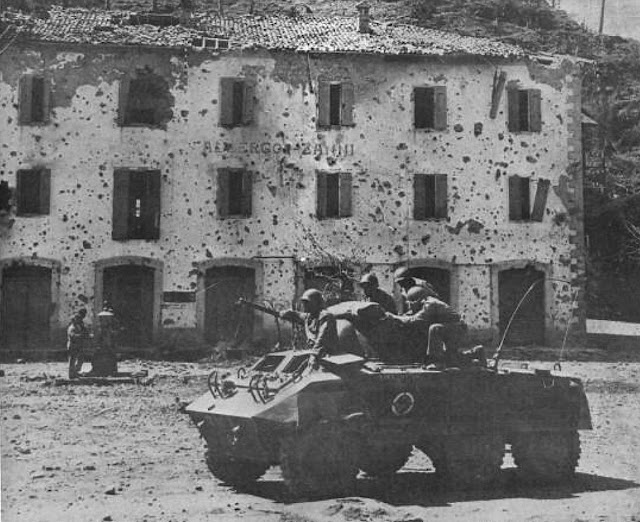 |
| Brazilian M8 Greyhound "VIRA MUNDO" (Wanderer) entering in Montese, Italy. April, 1945 |
 |
| Brazilian M8 Greyhound "TERESA" ready for battle waiting outside Montese, Italy. April, 1945 |
 |
| Brazilian M8 Greyhound passing through the ruins of Montese, after the capture of this city. April, 1945. |
 |
Ringed Southern Cross (Cruzeiro do Sul) Brazilian Army marking in WWII era. |
Captured M8 armored cars were used in modest numbers by the German Army during the war, though not in any organized fashion. Captured vehicles were usually given a quick set of German markings and used until they broke down.
 |
| German troops with captured M8s armored cars. Normandy, summer 1944. |
 |
| M8 recaptured by Americans, cannibalized by Germans to use parts for others captured M8s. |
The vehicle was considered fast, sufficiently reliable (after some technical problems were solved) and armed and armored well enough for reconnaissance missions. However, cavalry units criticized its off-road performance, which was even worse than the M3A1 White scout car it replaced.
In the mountainous terrain of Italy and in the deep mud and snow of North European winter, the M8 was more or less restricted to roads, which greatly reduced its value as a reconnaissance vehicle. To overcome this deficiency, the use of whell chains was very common.
It was also very vulnerable to landmines. An add-on armor kit was designed to provide an extra quarter-inch of belly armor to reduce landmine vulnerability. Some crews placed sandbags on the floor to make up for the thin belly armor. Another problem was that commanders often used their reconnaissance squadrons for fire support missions, for which the thinly-armored M8 was ill-suited. When it encountered German armored reconnaissance units, the M8 could easily penetrate their armor with its 37 mm gun. Conversely, its own thin armor was vulnerable to the 20 mm autocannons that German scout cars were equipped with.
 |
| M3A1 White scout car |
 |
| M8 Greyhound in Ardennes. Notice the snow chains were widely used by M8s to improve traction both on and off the road. |
During the Battle of St. Vith in the Battle of the Bulge, an M8 of Troop B, 87th Cavalry Reconnaissance Squadron was able to destroy a German Tiger I heavy tank. The M8 fired three 37 mm rounds through the relatively thin rear armor of the Tiger from only 25 yd (23 m), setting it on fire.
The U.S. Army started to look for a replacement for the M8 as early as 1943. Two prototypes, the Studebaker T27 and Chevrolet M38 were finished in summer 1944. Both were found to be superior to the M8, but it was decided that, at that stage of the war, there was no more need for a new armored car.
Post-WWII:
After the war, the M8 was used for occupation duty; it also saw combat in the Korean War, being retired by the U.S. Army shortly thereafter. In French use, the M8 was used during the Indochina War (1946–1954) and Algerian War (1954–1962). Many vehicles formerly used by the U.S., Britain and France were exported to NATO allies and third world countries. As of 2002, some still remained in service in Africa and South America.
During the Vietnam War, the French organized Vietnamese armored regiments, each consisting of three companies equipped with a mixture of M3 half-tracks, M3 scout cars, M8 Greyhound armored cars and M8 self-propelled howitzers.
During the Congo Crisis, Indian peacekeepers with recoilless rifles destroyed at least one ex-Belgian Greyhound manned by Katangese separatists. The armored cars were deployed on both sides during UN attempts to end Katanga's ill-fated secession.
Several Greyhounds were deployed in Bogota on March 8, 2007, as part of the security measures for U.S. President George W. Bush's visit. They are regularly used as checkpoint security by the Colombian military, and usually can be seen in the northern parts of the capital.
Variants:
-T22 light armored car - prototype
-T22E1 light armored car - a 4x4 prototype
-T22E2 light armored car - prototype eventually standardized as M8
-M8 light armored car - production variant
-M8E1 light armored car - a variant with modified suspension. Two vehicles were produced in 1943.
-M20 armored utility car, also known as the M20 scout car, was a Greyhound with the turret replaced with a low, armored open-topped superstructure and an anti-aircraft ring mount for a .50-in M2 heavy machine gun. A bazooka was provided for the crew to compensate for its lack of anti-armor weaponry. The M20 was primarily used as a command vehicle and for forward reconnaissance, but many vehicles also served as armored personnel carriers and cargo carriers. It offered high speed and excellent mobility, along with a degree of protection against small arms fire and shrapnel. When employed in the command and control role, the M20 was fitted with additional radio equipment. Originally designated the M10 armored utility car, it was redesignated M20 to avoid confusion with the M10 Wolverine tank destroyer. 3,680 M20s were built by Ford during its two years in production (1943–1944).
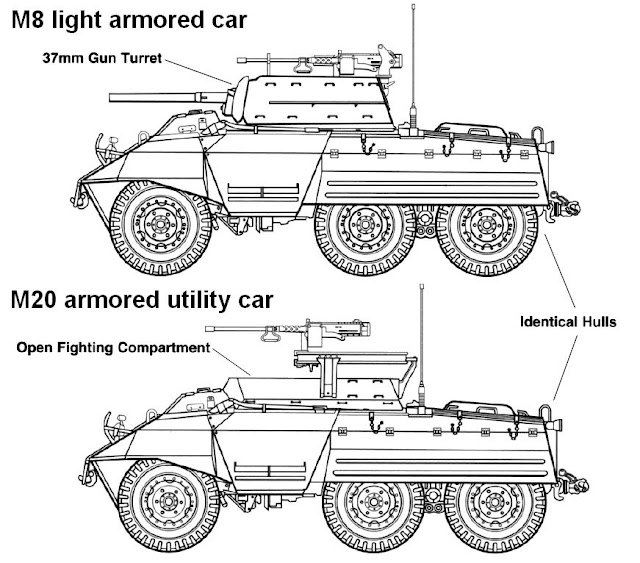 |
| M8 and M20 in comparative profiles |
-T69 multiple gun motor carriage - in late 1943, an anti-aircraft variant of the M8 was tested. The vehicle was armed with four .50-in machine guns in a turret developed by Maxson Corp.. The antiaircraft board felt that the vehicle was inferior to the M16 MGMC and the project was closed.
 |
| T69 AA-MGMC |
-M8 TOW tank destroyer - M8 upgraded by the US company Napco. The main gun was replaced by an .50-in machine gun and a BGM-71 TOWlauncher was installed above the turret. Upgraded vehicles were used by Colombia.
-M8/M20 H-90 - a French upgrade for the M20 showcased by GIAT Industries in 1971, which mounted a 90mm low-velocity gun adopted from thePanhard AML family of reconnaissance vehicles.
-CRR Brasileiro - a version developed in 1968 by the Brazilian Army Engineering Institute (IME). The middle axle was removed and a new engine (120 hp (89 kW) Mercedes-Benz OM-321) installed to create the VBB-1 of which one prototype was completed, the vehicle being found to be inferior. The Vbb-1 was, in turn, the basis for the CRR which reverted to a 6x6 configuration and eight vehicles were produced for evaluation. The EE-9 Cascavel was from the CRR.
-M8 (diesel) Hellenic Army armored car - a number of M8 armored cars were upgraded with a Steyr diesel engine in place of the Hercules JXD gasoline engine, this required a rearwards extension of the engine compartment by 11.8 in (300 mm), as well as some heightening. Also fitted were a new radio, indicator and new hooded lights, rear view mirrors, while the M2HB anti-aircraft machinegun was moved to the right front of the turret, where a new pintle socket was bolted on the partial roof (the turret rear socket being retained) and the coaxial 0.30-in M1919A4 replaced by a 7.62x51 mm NATO MG3 machinegun. Used for coastal defense and retired from service in the late 1990s.
-Colombian AM8- a Colombian fusion of turret-mounted World War II anti-air artillery in an M8 with a modern motor. It is a counter-insurgency weapon for use against guerrilla ambushes in the Colombian mountains.
Specs:
| M8 light armored car 6x6 | |
|---|---|
| Type | Armored car |
| Place of origin | United States |
| Specifications | |
| Weight | 8.6 short tons (7.8 t) |
| Length | 5.00 m |
| Width | 2.53 m |
| Height | 2.26 m |
| Crew | 4 |
Main armament | 37 mm gun M6 |
Secondary armament | .30 and .50 machine guns |
| Engine | Hercules JXD 6-cyl gasoline 110 hp (82 kW) |
| Power/weight | 14.1 hp/tonne |
| Suspension | 6x6 wheel, leaf spring |
Operational range | 560 km |
| Speed | 90 km/h |
The kits:
As I said earlier, I decided to make the Brazilian version of this vehicle. After penetrate my "Catacomb kits", I found that beyond the Tamiya kit that I had set aside for this project, I had a scrap of M8 kit from Italeri.
As I am adherent of the "Law of Conservation of Matter" in modeling (In the military modeling, nothing is lost, nothing is thrown away; everything is transformed!) I decided to reform the Italeri scrap and make two models of Brazilians M8s. A cobra vai fumar !!! (The snake will smoke!!! - The Brazilians motto...)
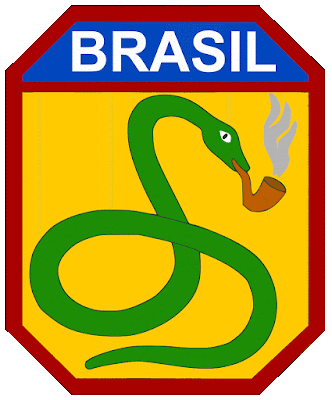 |
| Brazilian Expeditionary Force badge |
 |
| Walt Disney's drawing about the Brazilian Army badge signed by the author |
 |
| A little profile about Brazilian Army markings in WWII |
Well, first of all, the virgin kit: 1/35 Tamiya M8 Greyhound #35228:
...and the scrap kit; 1/35 Italeri M8 Greyhound #6364:
The kits in the workbench:
The Italeri's wheels are wrong: too small. I got a wheel set in resin from Electric (with chains) to replace the wrong wheels of Italeri.
For the markings:
 |
| The Tamiya kit and resin wheel sets.... |
 |
| Comparison sizes between Electric, Tamiya and Italeri |
 |
| The Electric resin wheels with chains... |
 |
| The resin wheels with reinforcements metal pins... |
 |
| The virgin Tamiya hull and the recicled Italeri one... |
 |
| More details...turrets, aerials (made with acupuncture needles) & etc... |
 |
| Primmed !!! |
 |
| ready for the decals... |
 |
| M8 Greyhound number 13 (without fenders) - Italeri |
 |
| M8 Greyhound number 6 VIRA MUNDO (Wanderer) (with fenders) - Tamiya |
With colors:
 |
| M8 Greyhound number 13 (without fenders) - Italeri |
 |
| front view |
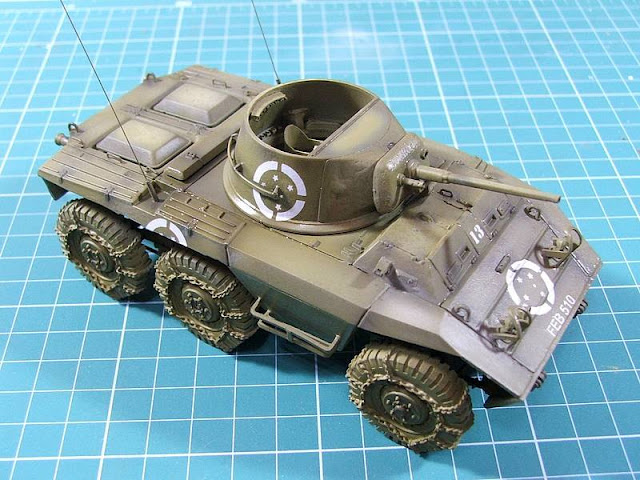 |
| 3/4 front right view |
 |
| 3/4 rear right view |
 |
| ...and M8 Greyhound number 6 - VIRA MUNDO (with fenders) - Tamiya |
 |
| Left view |
 |
| 3/4 rear left view |
 |
| 3/4 rear right view |
 |
| Right view |
 |
| The two Brazilian M8 Greyhounds |
 |
A Brazilian meeting: Renault FT 17 37mm gun, M8 Greyhounds and Renault FT 17 TSF (from back to front)) |
After the weathering, the girls are ready for action...
 |
| M8 Greyhound - 6x6 Armoured Car VIRA MUNDO vehicle number 6 - Brazilian Expeditionary Force 1st Expeditionary Infantry Division - 1st Recon Squadron Montese, Italy - April 1945. |
 |
| M8 Greyhound - 6x6 Armoured Car VIRA MUNDO left view |
 |
| M8 Greyhound - 6x6 Armoured Car VIRA MUNDO 3/4 rear left view |
 |
| M8 Greyhound - 6x6 Armoured Car VIRA MUNDO 3/4 rear right view |
 |
| M8 Greyhound - 6x6 Armoured Car VIRA MUNDO right view |
 |
| M8 Greyhound - 6x6 Armoured Car VIRA MUNDO |
 |
| M8 Greyhound - 6x6 Armoured Car VIRA MUNDO |
 |
| M8 Greyhound - 6x6 Armoured Car VIRA MUNDO |
 |
| M8 Greyhound - 6x6 Armoured Car VIRA MUNDO with Kojak. |
 |
| M8 Greyhound - 6x6 Armoured Car VIRA MUNDO vehicle number 6 - Brazilian Expeditionary Force 1st Expeditionary Infantry Division - 1st Recon Squadron Montese, Italy - April 1945. |
 |
| M8 Greyhound - 6x6 Armoured Car vehicle number 13 - Brazilian Expeditionary Force 1st Expeditionary Infantry Division - 1st Recon Squadron Montese, Italy - April 1945. |
 |
| M8 Greyhound - 6x6 Armoured Car 3/4 front left view |
 |
| M8 Greyhound - 6x6 Armoured Car left view |
 |
| M8 Greyhound - 6x6 Armoured Car 3/4 rear left view |
 |
| M8 Greyhound - 6x6 Armoured Car 3/4 rear right view |
 |
| M8 Greyhound - 6x6 Armoured Car right view |
 |
| M8 Greyhound - 6x6 Armoured Car 3/4 front right view |
 |
| M8 Greyhound - 6x6 Armoured Car front view |
 |
| M8 Greyhound - 6x6 Armoured Car with kojak. |
 |
| M8 Greyhounds - 6x6 Armoured Cars vehicle nbr. 6 VIRA MUNDO and 13. |
 |
| Kojak is a busy guy!! |
 |
Three Brazilian girls: M8 Greyhounds 6x6 ACs |
 |
| A cobra vai fumar!!! The snake is going to smoke!!! (Motto of Brazilian soldiers in Italy) |
See you soon, Boys !!!
Até logo !!!




















Hello!
ResponderExcluirExquisite magnificent report once again, and of course a great job
Odd how lots parts, like this, wheel diameter varies in different series
Nice this southern cross pattern
Are these two Acrux and Becrux (mimosa)
:) Fine is also a Disney cartoon
Brazil the only South American country that participated in the battles in Europe (WW-II)
Great job Doc! I saved the article for a future reference, since I have the Tamiya kit. Well done!
ResponderExcluirgreat Job :)
ResponderExcluir@Maximex. Thanks, Maximex !!! Indeed, Brazil was the only South American country that fought in WWII: Army, Navy and Air Force !!! Take care, my Finn friend !!!
ResponderExcluir@Sidney. Thanks, Sherife....Que bom que o artigo vai ser ùtil para vc e o seu Tamiya...qquer coisa, me tecle....take care !!!
@Marcius Costa: Thanks, man....Um grande abraço !!!
show doc. Ffernandes2 by wk
ResponderExcluirshow doc. Ffernandes2 by wk
ResponderExcluirOpa...valeu, Ffernandes...Um abração!!!
ResponderExcluirExcelente trabalho de pesquisa. Meus parabéns.
ResponderExcluirOdair R.
Muito obrigado Odair!!! UM ABRAÇO!!!
ExcluirExcelente apresentação, quanto aos kits, sem palavras.
ResponderExcluirMuito obrigado FEB Reenactors! A casa é sua para visitar e participar, sempre que puder!!!
ExcluirDear Panzerserra,
ResponderExcluirtudo bem? I really enjoy your blog and it is always a pleasure and inspiration to read your reports!
But today I have a question concerning your greyhound and other FEB models:
I am currently planning to build a small diorama with a FEB Greyhound for a brazilian friend in 1:35. The only problem I have (so far in the planning phase) is that I could not find any vendor who sells decals in 1:35, neither here in Germany, nor anywhere else on the internet. So, my humble question: Do you have any idea where to get such decals?
Thank you in advance for your help!
With the very best wishes from Germany!
Hi, Alemao!! All the best and thanks for your incentive. About decals, please write to Marcelo Bertolin. ephobby@uol.com.br
ExcluirHe is a model maker who makes pieces out of resin and prints decals, including those from FEB. You can quote my name when you write to him. He's a really nice guy and will be able to help you. Good luck with your project and anything, write again.
Um grande abraço!!
Olá Serra!
ResponderExcluirComo sempre, é uma aula ler os seus artigos aqui no blog. Tenho uma dúvida sobre a cor do "floor" do M8 Greyhound. Por tudo o que li até então, tudo o que pode ser avistado pelo ar (aviões etc.) era pintado em Olive Drab para não dar o "contraste" e entregar a posição do veículo de forma rápida e imediata. Sei que todas as laterais internas e o "cesto" da torre eram na cor branca, mas o que me diz do "floor"?
Como é um "open top" e quando o motorista e o auxiliar abriam as escotilhas, o "floor" seria visto do alto, como eu disse, portanto, para mim deveria ser em Olive Drab, não?
Forte abraço e aguardo os seus comentários.
Alexandre - Campinas/SP ("atcampos1" da Webkits).
Oi Alexandre (atcampos1)!! legal te ver por aqui... Sim, o que voce diz é completamente lógico e faz todo o sentido. Podemos e devemos construir nossos modelos assim... Embora em tempos de guerra e de produção em massa, duvido que todos os veículos saissem das linhas de montagem com esse cuidado. Portanto, podemos encontrar alguns veículos com o interior com superficies verticais pintadas em branco e as horizontais inferiores pintadas na cor do veículo, como seria o certo. Mas mesmo que o assoalho (floor), estivesse pintado de branco , ao sair da fábrica (ou de um overhaul nas oficinas de frente de combate...) logo, logo esse piso estaria de tudo o que é cor, menos branco, pois as botas dos tripulantes, o barro, a terra mais o óleo e a fuligem no reticulado do soalho desses veículos se encarregaria de diminuir e até mesmo de neutralizar o "flash" do branco pelas escotilhas ou pela torreta aberta. Acho que as duas opções são perfeitamente aceitáveis. Em se tratatando de WW II, eu sigo a regra do "Nunca diga nunca... nunca diga sempre!! Um grande abraço e volte sempre.... Prazer te ver por aqui!!!
Excluir